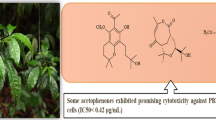Summary
Investigation of the host-specific toxin complex fromH. sacchari has led to the isolation of 3 isomeric glycosidic components C39H64O22, each active at 2×10−11 moles. The 3 isomers consist of 4 galactose units linked to an aglycone residue C15H24O2.
Similar content being viewed by others
References
O.C. Yoder, A. Rev. Phytopath.18, 103 (1980).
J.M. Daly, In: Specificity in Plant Diseases, p. 231, Ed. R.K.S. Wood and A. Graniti Plenum, New York 1976.
G.W. Steiner and G.A. Strobel, J. biol. Chem.246, 4350 (1971).
R.S. Livingston and R.P. Scheffer, J. biol. Chem.256, 1705 (1981).
R.P. Scheffer and R.S. Livingston, Phytopathology70, 400 (1980).
R. C. Beier, Ph. D. thesis, Department of Chemistry, Montana State University, Bozeman, Montana 1980.
H.H. Luke and H.E. Wheeler, Phytopathology45, 453 (1955).
G.W. Steiner and R.S. Byther, Phytopathology61 691 (1971).
T. Tanimura, J.J. Pisano, Y. Ito and R.L. Bowman, Science169, 54 (1970).
Field desorption mass spectral data were obtained by the Middle Atlantic Mass Spectrometry Laboratory, Baltimore, Maryland, a National Science Foundation Shared Instrumentation Facility.
A.K. Bose, H. Fujiwara and B.N. Pramanik, Tetrahedron Lett.1979, 4017.
A.K. Ganguly, N.F. Cappuccino, H. Fujiwara and A.K. Bose, J. chem. Soc. chem Commun.1979, 148.
M.A. Baldwin and F.W. McLafferty, Org. Mass Spectrom.7, 1353 (1973).
Author information
Authors and Affiliations
Additional information
Acknowledgments. The Boyce Thompson-Cornell group thanks J.F. Rissler, University of Maryland, A.K. Bose, Stevens Institute of Technology, R. Barker and A. Serriani, Cornell University, and C. Grinnalds and J. Golay, Boyce Thompson Institute for help with various aspects of this work. Supported in part by a grant to V.M. from the US Department of Agriculture (8100720). The Zürich group thanks Dr G.A. Strobel, Department of Botany and Microbiology, Montana State University, Bozeman, for supplying a potent toxin-producing strain (M 36), a susceptible clone of sugarcane (51 NG 97), and a reference sample of helminthosporoside, Dr. K. Hostettmann and Mme M. Hostettmann-Kaldas, Pharmazeutisches Institut ETH Zürich, for assistance in developing the DCC separation and Sandoz A.G., Basel, for financial support.
Rights and permissions
About this article
Cite this article
Macko, V., Goodfriend, K., Wachs, T. et al. Characterization of the host-specific toxins produced byHelminthosporium sacchari, the causal organism of eyespot disease of sugarcane. Experientia 37, 923–924 (1981). https://doi.org/10.1007/BF01971755
Published:
Issue Date:
DOI: https://doi.org/10.1007/BF01971755




